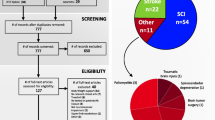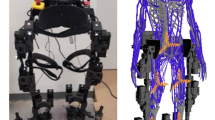Abstract
Power lower limb exoskeleton has gained considerable interests since it is widely applied in both walking assistance and rehabilitation related applications. The most challenge problem of these kinds lower exoskeletons is how to deal with the complex environment, such as stairs in daily life. Based on a developed lower limb exoskeleton named AssItive DEvice for paRalyzed patients (AIDER), this paper proposed a novel stair parameters perception approach named Stick From the Origin (SFO) and a bio-spired stair gait trajectory generator based on Dynamic Movement Primitives (DMPs) and summarized the joint torque and power requirements. With two distance sensors, the low-cost and real-time stair parameters perception approach could be tested and verified in practice with acceptable accuracy. During the process, the Center of Pressure (CoP) of the whole system would be concerned to keep the pilot’s safety. With the reference stair gait and stair parameters brought in, a natural and flexible stair-ascent gait can be generated by the bio-spired stair gait trajectory generator based on DMPs, which was validated in practical application on the AIDER system with and without pilot. Based on the averaged torques and power across these trials, the peak body-mass-normalized knee and hip joint power, knee and hip torque during the stair-ascent movement are 1.82 W/kg and 1.52 W/kg, 1.36 Nm/kg and 1.22 Nm/kg, which are required during the process of lifting the leg onto the stair tread.















Similar content being viewed by others

References
Aach, M., Meindl, R., Hayashi, T., Lange, I., Geßmann, J., Sander, A., Nicolas, V., Schwenkreis, P., Tegenthoff, M., Sankai, Y., Schildhauer, TA.: Exoskeletal neuro-rehabilitation in chronic paraplegic patients–initial results. In: Pons, J.L., Torricelli, D., Pajaro, M. (eds.) Converging Clinical and Engineering Research on Neurorehabilitation, pp. 233–236. Springer, Berlin, Heidelberg (2013)
Aach, M., Cruciger, O., Sczesny-Kaiser, M., Höffken, O., Meindl, R.C., Tegenthoff, M., Schwenkreis, P., Sankai, Y., Schildhauer, T.A.: Voluntary driven exoskeleton as a new tool for rehabilitation in chronic spinal cord injury: a pilot study. Spine J. 14(12), 2847–2853 (2014)
Albert, A., Suppa, M., Gerth, W.: Detection of stair dimensions for the path planning of a bipedal robot. In: 2001 IEEE/ASME international conference on advanced intelligent mechatronics. Proceedings (Cat. No.01TH8556), vol 2, pp 1291–1296. https://doi.org/10.1109/AIM.2001.936909 (2001)
Chen, Q., Cheng, H., Yue, C., Huang, R., Guo, H.: Dynamic balance gait for walking assistance exoskeleton. Appl. Bionics Biomech. 2018, 1–10 (2018). https://doi.org/10.1155/2018/7847014
Colombo, G., Joerg, M., Schreier, R., Dietz, V., et al.: Treadmill training of paraplegic patients using a robotic orthosis. J. Rehabilit. Res. Dev. 37(6), 693–700 (2000)
Duan, R., Yu, S., Yue, G., Foulds, R., Feng, C., Tian, Y., Su, H.: Real-time robust 3d plane extraction for wearable robot perception and control. Frontiers in Biomedical Devices, vol 2018, Design of Medical Devices Conference (2018). https://doi.org/10.1115/DMD2018-6964
Esquenazi, A.: New bipedal locomotion option for individuals with thoracic level motor complete spinal cord injury. J Spinal Res Fund. 8, 26–28 (2013)
Esquenazi, A., Talaty, M., Packel, A., Saulino, M.: The rewalk powered exoskeleton to restore ambulatory function to individuals with thoracic-level motor-complete spinal cord injury. Am. J. Phys. Med. Rehabilit. 91(11), 911–921 (2012)
Fajen, B.R., Warren, W.H., Temizer, S., Kaelbling, L.P.: A dynamical model of visually-guided steering, obstacle avoidance, and route selection. Int. J. Comput. Vis. 54(1–3), 13–34 (2003)
Farris, R.J., Quintero, H.A., Goldfarb, M.: Performance evaluation of a lower limb exoskeleton for stair ascent and descent with paraplegia. In: 2012 Annual international conference of the IEEE engineering in medicine and biology society, pp. 1908–1911 (2012)
Fineberg, D.B., Asselin, P., Harel, N.Y., Agranova-Breyter, I., Kornfeld, S.D., Bauman, W.A., Spungen, A.M.: Vertical ground reaction force-based analysis of powered exoskeleton-assisted walking in persons with motor-complete paraplegia. J. Spinal Cord Med. 36(4), 313–321 (2013)
Gancet, J., Ilzkovitz, M., Motard, E., Nevatia, Y., Letier, P., de Weerdt, D., Cheron, G., Hoellinger, T., Seetharaman, K., Petieau, M., Ivanenko, Y., Molinari, M., Pisotta, I., Tamburella, F., Labini, F.S., d’Avella, A., van der Kooij, H., Wang, L., van der Helm, F., Wang, S., Zanow, F., Hauffe, R., Thorsteinsson, F.: Mindwalker: Going one step further with assistive lower limbs exoskeleton for sci condition subjects. In: 2012 4th IEEE RAS EMBS international conference on biomedical robotics and biomechatronics (BioRob), pp. 1794–1800 (2012)
Gutmann, J., Fukuchi, M., Fujita, M.: Stair climbing for humanoid robots using stereo vision. In: 2004 IEEE/RSJ international conference on intelligent robots and systems (IROS) (IEEE Cat. No.04CH37566), vol. 2, pp. 1407–1413. https://doi.org/10.1109/IROS.2004.1389593 (2004)
Harms, H., Rehder, E., Schwarze, T., Lauer, M.: Detection of ascending stairs using stereo vision. In: 2015 IEEE/RSJ international conference on intelligent robots and systems (IROS), pp. 2496–2502. (2015). https://doi.org/10.1109/IROS.2015.7353716
Hayashi, T., Kawamoto, H., Sankai, Y.: Control method of robot suit hal working as operator’s muscle using biological and dynamical information. In: 2005 IEEE/RSJ international conference on intelligent robots and systems, IEEE, pp. 3063–3068, 2005
Hayashi, Y., Kiguchi, K.: Stairs-ascending/descending assist for a lower-limb power-assist robot considering zmp. In: 2011 IEEE/RSJ international conference on intelligent robots and systems, pp. 1755–1760. (2011). https://doi.org/10.1109/IROS.2011.6094783
Hesch, J.A., Mariottini, G.L., Roumeliotis, S.I.: Descending-stair detection, approach, and traversal with an autonomous tracked vehicle. In: 2010 IEEE/RSJ international conference on intelligent robots and systems, pp. 5525–5531. (2010). https://doi.org/10.1109/IROS.2010.5649411
Ijspeert, A.J., Nakanishi, J., Shibata, T., Schaal, S.: Nonlinear dynamical systems for imitation with humanoid robots. In: Proceedings of the IEEE/RAS international conference on humanoids robots (Humanoids2001), CONF, pp. 219–226, 2001
Ijspeert, A.J., Nakanishi, J., Hoffmann, H., Pastor, P., Schaal, S.: Dynamical movement primitives: learning attractor models for motor behaviors. Neural Comput. 25(2), 328–373 (2013)
Jezernik, S., Colombo, G., Morari, M.: Joint-angle trajectory adaptation for the robotic orthosis lokomat. In: Proceedings of the workshop on European scientific and industrial collaboration (WESIC), Enschede, The Netherlands, pp. 451–456, 2001
Kawamoto, H., Sankai, Y.: Power assist method based on phase sequence and muscle force condition for hal. Adv. Robot. 19(7), 717–734 (2005)
Kawamoto, H., Lee, S., Kanbe, S., Sankai, Y.: Power assist method for hal-3 using emg-based feedback controller. In: SMC’03 conference proceedings. 2003 IEEE International conference on systems, man and cybernetics. Conference theme-system security and assurance (Cat. No. 03CH37483), IEEE, vol. 2, pp. 1648–1653, 2003
Kawashima, N., Sone, Y., Nakazawa, K., Akai, M., Yano, H.: Energy expenditure during walking with weight-bearing control (wbc) orthosis in thoracic level of paraplegic patients. Spinal Cord 41(9), 506 (2003)
Kolakowsky-Hayner, S.A., Crew, J., Moran, S., Shah, A.: Safety and feasibility of using the ekso bionic exoskeleton to aid ambulation after spinal cord injury. J. Spine 4, 3 (2013)
Ma, W., Cheng, H., Huang, R., Chen, Q.: Gait planning with dynamic movement primitives for lower limb exoskeleton walking up stairs. In: 2018 IEEE international conference on robotics and biomimetics (ROBIO), pp. 703–708, 2018
Maeshima, S., Osawa, A., Nishio, D., Hirano, Y., Takeda, K., Kigawa, H., Sankai, Y.: Efficacy of a hybrid assistive limb in post-stroke hemiplegic patients: a preliminary report. BMC Neurol. 11(1), 116 (2011)
Nakanishi, J., Morimoto, J., Endo, G., Cheng, G., Schaal, S., Kawato, M.: A framework for learning biped locomotion with dynamical movement primitives. In: 4th IEEE/RAS international conference on humanoid robots, 2004, vol. 2, pp. 925–940, 2004
Nilsson, A., Vreede, K.S., Häglund, V., Kawamoto, H., Sankai, Y., Borg, J.: Gait training early after stroke with a new exoskeleton-the hybrid assistive limb: a study of safety and feasibility. J. Neuroeng. Rehabilit. 11(1), 92 (2014)
Ohta, Y., Yano, H., Suzuki, R., Yoshida, M., Kawashima, N., Nakazawa, K.: A two-degree-of-freedom motor-powered gait orthosis for spinal cord injury patients. Proc. Inst. Mech. Eng. Part H J. Eng. Med. 221(6), 629–639 (2007)
Pack, D.J.: Perception-based control for a quadruped walking robot. In: Proceedings of IEEE international conference on robotics and automation, vol. 4, pp. 2994–3001. (1996). https://doi.org/10.1109/ROBOT.1996.509167
Pastor, P., Righetti, L., Kalakrishnan, M., Schaal, S.: Online movement adaptation based on previous sensor experiences. In: 2011 IEEE/RSJ international conference on intelligent robots and systems, pp. 365–371, 2011
Sczesny-Kaiser, M., Höffken, O., Lissek, S., Lenz, M., Schlaffke, L., Nicolas, V., Meindl, R., Aach, M., Sankai, Y., Schildhauer, T.A., Tegenthoff, M., Schwenkreis, P.: Neurorehabilitation in chronic paraplegic patients with the hal\({\textregistered }\) exoskeleton–preliminary electrophysiological and fmri data of a pilot study. In: Pons, J.L., Torricelli, D., Pajaro, M. (eds.) Converging Clinical and Engineering Research on Neurorehabilitation, pp. 611–615. Springer, Berlin, Heidelberg (2013)
Stahlschmidt, C., Gavriilidis, A., Kummert, A.: Classification of ascending steps and stairs using time-of-flight sensor data. In: 2015 IEEE 9th international workshop on multidimensional (nD) systems (nDS), pp. 1–6. (2015). https://doi.org/10.1109/NDS.2015.7332643
Strickland, E.: Good-bye, wheelchair. IEEE Spectr. 49(1), 30–32 (2012)
Talaty, M., Esquenazi, A., Briceno, J.E.: Differentiating ability in users of the rewalk tm powered exoskeleton: An analysis of walking kinematics. In: 2013 IEEE 13th international conference on rehabilitation robotics (ICORR), IEEE, pp. 1–5, 2013
Woo, S., Shin, J., Lee, Y.H., Hun Lee, Y., Lee, H., Kang, H., Choi, H.R., Moon, H.: Stair-mapping with point-cloud data and stair-modeling for quadruped robot. In: 2019 16th international conference on ubiquitous robots (UR), pp. 81–86, (2049). https://doi.org/10.1109/URAI.2019.8768786
Yano, H., Kaneko, S., Nakazawa, K., Yamamoto, S., Bettoh, A.: A new concept of dynamic orthosis for paraplegia: the weight bearing control (wbc) orthosis. Prosthet. Orthot. Int. 21(3), 222–228 (1997)
Zeilig, G., Weingarden, H., Zwecker, M., Dudkiewicz, I., Bloch, A., Esquenazi, A.: Safety and tolerance of the rewalk exoskeleton suit for ambulation by people with complete spinal cord injury: a pilot study. J. Spinal Cord Med. 35(2), 96–101 (2012)
Acknowledgements
This work is supported by the National Key Research and Development Program of China (no. 2017YFB1302300), National Natural Science Foundation of China (NSFC) under Grant no. 61603078 and no. U1613223.
Author information
Authors and Affiliations
Corresponding author
Additional information
Publisher's Note
Springer Nature remains neutral with regard to jurisdictional claims in published maps and institutional affiliations.
This paper is submitted for possible publication in the focused section on Robust Perception and Learning for Robots in Dynamic Environments.
Rights and permissions
About this article
Cite this article
Xu, F., Huang, R., Cheng, H. et al. Stair-ascent strategies and performance evaluation for a lower limb exoskeleton. Int J Intell Robot Appl 4, 278–293 (2020). https://doi.org/10.1007/s41315-020-00123-6
Received:
Accepted:
Published:
Issue Date:
DOI: https://doi.org/10.1007/s41315-020-00123-6



